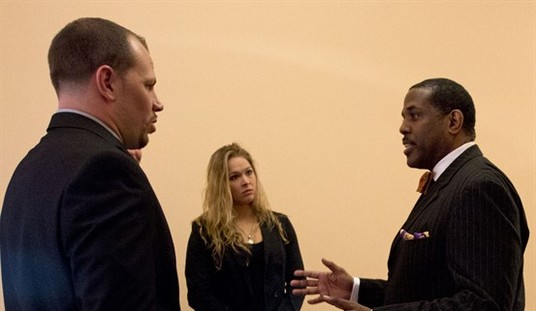Steve McIntyre, whose previous careers included mineral exploration and policy analysis for the Canadian government, has been one of the foremost critics “of the temperature record of the past 1000 years and the data quality of NASA’s Goddard Institute for Space Studies.” His detailed look into the data quality of the so-called Hockey Stick graph (see below) upon which much of the Global Warming thesis has been based, unearthed problems that the National Research Council was tasked by Congress to investigate. They concluded in 2006 that “there were statistical shortcomings in the MBH analysis, but … they were small in effect”.

The "Hockey Stick"
Unsatisfied, McIntyre went looking for the original data and it proved surprisingly hard to get. His requests for access were refused. The journal Nature reported on his efforts to obtain them.
“A leading UK climatologist is being inundated by freedom-of-information-act requests to make raw climate data publicly available, leading to a renewed row over data access. Since 2002, Steve McIntyre, the editor of Climate Audit, a blog that investigates the statistical methods used in climate science, has repeatedly asked Phil Jones, director of the Climatic Research Unit (CRU) at the University of East Anglia, UK, for access to monthly global surface temperature data held by the institute.”
The data in question was called the Yamal dataset; it involved the measurements of a number of tree cores which were used as proxy data for temperature. It was alleged that the growth rings from these trees ‘proved’ that “late 20th century warmth is unprecedented for at least roughly the past two millennia for the Northern Hemisphere.” Yet this key data was nowhere in the public domain; it was locked up tighter than a Hawaii birth certificate. When finally it was brought into the open it didn’t show what it was supposed to prove. The Register takes up the story.
At the insistence of editors of the Royal Society’s Philosophical Transactions B the data has leaked into the open – and Yamal’s mystery is no more. From this we know that the Yamal data set uses just 12 trees from a larger set to produce its dramatic recent trend. Yet many more were cored, and a larger data set (of 34) from the vicinity shows no dramatic recent warming, and warmer temperatures in the middle ages. In all there are 252 cores in the CRU Yamal data set, of which ten were alive 1990. All 12 cores selected show strong growth since the mid-19th century. The implication is clear: the dozen were cherry-picked.
Two things had happened: first, due to McIntyre’s efforts, the Yamal data was proved suspect and second, he found a more reliable dataset from right next door to Yamal. Now the stage was set for reproducing the hockey stick. Bishop Hill sets up the narrative, taking us back to the hunt for the data which produced Yamal itself; which turned out to be a replacement for the Polar Urals data which proved unreliable.
We can pick up the narrative again in 2005, when McIntyre discovered that an update to the Polar Urals series had been collected in 1999. Through a contact he was able to obtain a copy of the revised series. Remarkably, in the update the eleventh century appeared to be much warmer than in the original – in fact it was higher even than the twentieth century. This must have been a severe blow to paleoclimatologists, a supposition that is borne out by what happened next, or rather what didn’t: the update to the Polar Urals was not published, it was not archived and it was almost never seen again. With Polar Urals now unusable, paleclimatologists had a pressing need for a hockey stick shaped replacement and a solution appeared in the nick of time in the shape of a series from the nearby location of Yamal.
The Yamal data had been collected by a pair of Russian scientists, Hantemirov and Shiyatov, and was published in 2002. In their version of the data, Yamal had little by way of a twentieth century trend. Strangely though, Briffa’s version, which had made it into print before even the Russians’, was somewhat different. While it was very similar to the Russians’ version for most of the length of the record, Briffa’s verison had a sharp uptick at the end of the twentieth century — another hockey stick, made almost to order to meet the requirements of the paleoclimate community.
Yamal was the fallback and McIntyre wanted to see it. But remarkably Briffa would not release the base data. “McIntyre therefore wrote to the Englishman asking for the original tree ring measurements involved. When Briffa refused, McIntyre wrote to Science, who had published the new paper, pointing out that, since it was now six years since Briffa had originally published his version of the chronology, there could be no reason for withholding the underlying data. After some deliberation, the editors at Science declined the request, deciding that Briffa did not have to publish anything more as he had merely re-used data from an earlier study. McIntyre should, they advised, approach the author of the earlier study, that author being, of course, Briffa himself. Wearily, McIntyre wrote to Briffa again, this time in his capacity as author of the original study in Quaternary Science Reviews and he was, as expected, turned down flat.” In a novel this refusal would have been put down to a deep and deadly conspiracy. What it really concealed was the slipshod data handling, tiny samples, the loss of essential metadata and the careless merging of datasets on which the earlier conclusions were based.
This became evident when Briffa’s data made its way into the light of day unnanounced. McIntyre was alerted to its existence by a reader who spotted it. Bishop continues, “eventually, though, Briffa’s hand was forced, and in late September 2009, a reader pointed out to McIntyre that the remaining data was now available. It had been quietly posted to Briffa’s webpage, without announcement or the courtesy of an email to Mcintyre.” And it was easy to see why the data was more comfortable in the shadow. Only 12 cores had been used as datapoints. This was it? Where were the rest? Attempts to rectify the fatal errors in the Yamal dataset were tried by McIntyre, but it remained a mess. The problem was eventually resolved when the “Schweingruber series called Khadyta River close by to Yamal” was discovered. Here was clean data from right next door.
McIntyre therefore prepared a revised dataset, replacing Briffa’s selected 12 cores with the 34 from Khadyta River. The revised chronology was simply staggering. The sharp uptick in the series at the end of the twentieth century had vanished, leaving a twentieth century apparently without a significant trend. The blade of the Yamal hockey stick, used in so many of those temperature reconstructions that the IPCC said validated Michael Mann’s work, was gone.
The most amazing part of this story from my point of view was the way in which a dogged Canadian mathematician, acting practically alone with the help of his trusty readers, forced the establishment back step by step to explain where the conclusions upon which a trillion dollar public policy came from and insisted on reproducing the results. If ever there was a tale of triumph over dauntless odds — almost to the point of comparing it to breaking the bank — this is it. The story of man’s search for the scientific truth is still ongoing. Research doesn’t end with McIntyre. It may still prove to be the case that the Hockey Stick exists, but it must be shown on the basis of the data, not on the strength of “consensus” and public relations campaigns. What McIntyre showed is that nothing beneath the stars need be taken on authority. Whether the truth will set you free is a proposition not all will accept; but at least the search for it will.
[youtube HAAZVLl8iOg]









Join the conversation as a VIP Member